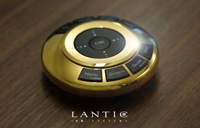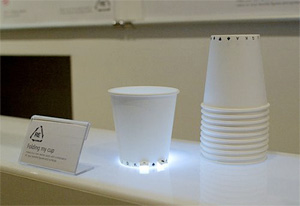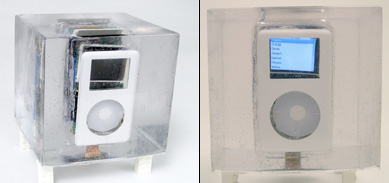"It's yet another in a long series of diversions in an attempt to avoid responsibility." - Chris Knight
Archive for the ‘Geekery’ Category
Folding Cup: Flawed Cootie Avoiding Concept
December 6th, 2007 by iDunzo
The premise of the Folding Cup is that, at a party, you are forever in danger of grabbing somebody else’s paper cup.
Designer Jaehyung Hong solves this problem with tiny fold up tabs around the base, each carrying a number, letter or symbol from a deck of cards:
So. The procedure: First, choose a code and twist the tabs to mark your drink.
Second. Try to remember it.
Third, try to both read and remember the code after several cocktails.
See the problem? The concept will probably never surface, but don’t despair.
The time honored method still works: write your name on the cup with a sharpie. And use big letters.
 Posted in Food + Geekery + Technology + Toys & Gadgets |
Posted in Food + Geekery + Technology + Toys & Gadgets |  Comments Off on Folding Cup: Flawed Cootie Avoiding Concept
Comments Off on Folding Cup: Flawed Cootie Avoiding Concept
Exploded Apple iPod, Encased in Resin
November 28th, 2007 by iDunzo
This Apple iPod has been split and separated like an exploded diagram, and encased in resin. The amazing thing is that it still works.
Poured in layers, just like jelly, the iPod sits in a bubbly cube, with control via the included dock internals and the project, by Billy Chasen, is made geek-perfect by the inclusion of Lego feet.
Hopefully Billy will go to work on a more recursive meta-project next: An Apple G4 Cube, encased in a cube.
 Posted in Apple + Geekery + Technology + Toys & Gadgets |
Posted in Apple + Geekery + Technology + Toys & Gadgets |  Comments Off on Exploded Apple iPod, Encased in Resin
Comments Off on Exploded Apple iPod, Encased in Resin
$800 Mini-Guitar Fits In Suitcase
November 27th, 2007 by iDunzo
Want a tiny, bad, $800 guitar? Hammacher Schlemmer delivers.
Named The World’s Smallest Percision Electric Guitar, the thing is 1/6 the size of a standard example and is just over two feet long. It has a full complement of 20 frets.
For a laugh, read the marketing blatherskite:
Its injection-molded high-impact polymer composite body is filled with billions of tiny air bubbles that reproduce the cellular structure of wood, giving the guitar the same resonant properties of hardwoods used in standard-sized guitars without the expansion and contraction associated with wood.
I think he’s saying it’s made of plastic.
 Posted in Geekery + Music + Technology + Toys & Gadgets |
Posted in Geekery + Music + Technology + Toys & Gadgets |  Comments Off on $800 Mini-Guitar Fits In Suitcase
Comments Off on $800 Mini-Guitar Fits In Suitcase
Lantic Systems $30,000 Gold Remote Control
November 19th, 2007 by iDunzo
 Meet the World’s stupidest remote control.
Meet the World’s stupidest remote control.
Sure, it has functionality to spare. It will control everything, including CCTV, air-conditioning, burglary alarm, lights, curtains, and even – the press release claims – the internet.
Well ok, maybe not the internet, but it did mention email and technically that’s part of the internet.
The problem here is that the $30,000.00 price tag is dictated solely by the decoration. The stock RC-1, from yacht makers Lantic Systems, is expensive at $1,050.00, but for what it does, not way overpriced.
The Gold RC-1, though, is exactly the same, except clad in gold.
That said, if you own a yacht, you’re probably the kind of sad showoff who needs to display his wealth by any means available.
If so, you can pre order now, for a December delivery.
Source: Lantic Systems
 Posted in Geekery + Technology + Toys & Gadgets |
Posted in Geekery + Technology + Toys & Gadgets |  Comments Off on Lantic Systems $30,000 Gold Remote Control
Comments Off on Lantic Systems $30,000 Gold Remote Control
Planets Collide! Not Just In The Movies Anymore
November 15th, 2007 by iDunzo
The early days of planetary solar systems can be violent times indeed. Our own moon was most likely birthed from a stupendous collision, before our own solar system had settled down into the relatively placid routine we see today.
Astronomers have been observing a star system called HD 23514 in the Pleiades cluster that seems to be going through the same bumper-cars evolution as our own, with rocky planets potentially similar to Mercury, Venus, Earth and Mars in the process of formation.

Using an infrared camera with the Gemini North Telescope in Hawaii, a UCLA-led team has found hot dust surrounding a star much like our own Sun, but about 45 times younger.
The warm dust appears to indicate what they call “catastrophic collisions” in a region roughly comparable to the space between the orbits of Mercury and Mars in our own solar system.
They believe that so-called planetary embryos – rocky bodies that are evolving into full-fledged planets – must have recently bumped, breaking up or even pulverizing one another. Says Inseok Song of the Spitzer Science Center:
“In the process of creating rocky, terrestrial planets, some objects collide and grow into planets, while others shatter into dust; we are seeing that dust,” Song said.
Researchers said this was the first evidence of planet formation in the Pleiades, and further supports the notion that terrestrial planets like those in our own solar system are relatively common.
Source: Gemini Observatory
 Posted in Geekery + Technology |
Posted in Geekery + Technology |  Comments Off on Planets Collide! Not Just In The Movies Anymore
Comments Off on Planets Collide! Not Just In The Movies Anymore
Artificial Snow Falls for the First Time
November 13th, 2007 by iDunzo
November 13, 1946: Artificial snow is produced for the first time in the clouds over Mt. Greylock, Massachusetts.
While not exactly a blizzard — in fact, no snow ever hit the ground — it was the harbinger of a new industry and was an overnight sensation.
Using pellets of dry ice (frozen carbon dioxide), Vincent Schaefer, a scientist working for General Electric, seeded the clouds from an altitude of 14,000 feet. He was carrying out the first field experiment resulting from lab work in which he had successfully created precipitation by placing dry ice in a chilled chamber.
Flying over Mt. Greylock (the highest point in the Berkshires of western Massachusetts), Schaefer dropped his pellets and produced a similar effect in the clouds, which resulted in snow that fell an estimated 3,000 feet before evaporating in the dry air.
Artificial snow, like so many other scientific innovations, was born out of wartime necessity. In this case, it began during World War II and experiments with the creation of artificial fog, meant to conceal ships at sea.
Schaefer, a research associate under Nobel Prize-winner Irving Langmuir, began examining the physics of cloud formation. This work led him to his postwar experiments with cloud seeding, and the ultimate development of artificial snow.
Despite protests that artificial snow shouldn’t be used because it messed with Mother Nature’s design, it only took a few years for ski resorts to begin looking for ways to create the fake stuff for use during bad snow years.
Nowadays, artificial snow is made using a variety of machines and seeding methods. In addition to the ski industry, artificial snow is also popular on movie sets and in places where snow doesn’t normally fall.
Source: Massmoments.org and Sciencedaily.com
 Posted in Geekery + Technology + Trivia |
Posted in Geekery + Technology + Trivia |  Comments Off on Artificial Snow Falls for the First Time
Comments Off on Artificial Snow Falls for the First Time


